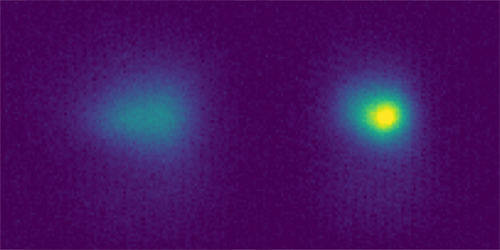• Physics 17, s47
Dense ensembles of laser-cooled molecules allow the observation of molecular collisions—a result that could lead to applications of cold molecular gases in quantum simulation and fundamental physics tests.
Ultracold molecules are promising platforms for quantum simulation and for precision tests of fundamental physics. A key prerequisite for these applications is the availability of clouds of laser-cooled molecules sufficiently dense for the rate of molecular collisions to become significant. So far, however, demonstrated bulk gases have been too dilute to enter this regime. Now Varun Jorapur at the University of Chicago and colleagues have packed thousands of diatomic strontium fluoride (SrF) molecules to densities large enough for the researchers to spot signatures of inelastic molecular collisions [1]. This high density could allow gases to be cooled enough to enter a “quantum degenerate” regime, the researchers say.
Gas density is crucial to achieving ultralow temperatures because it enables so-called evaporative cooling—a technique that involves slowing down the molecules through repeated elastic collisions with other molecules. Researchers have previously observed collisions in bulk gases containing molecules assembled from laser-cooled atoms, but these schemes only work for a small set of bialkali molecules. The new scheme, which directly traps laser-cooled molecules, has much broader applicability, says Jorapur.
The scheme involves three trapping steps. The first two use magneto-optical traps (MOTs) produced by combining a spatially varying magnetic field and six laser beams. The choice of different MOT laser frequencies—red- and blue-detuned with respect to the relevant molecular transition—enhanced the cooling and optimized the transfer of molecules to the third stage, a purely optical trap. The evidence for inelastic collisions came from the decay in the number of trapped SrF molecules over time: such collisions can cause molecules to react or form complexes that subsequently leave the trap. The researchers next plan to apply microwave-based schemes that suppress the rate of inelastic collisions while enhancing the rate of the elastic collisions beneficial for cooling.
–Matteo Rini
Matteo Rini is the Editor of Physics Magazine.
References
- V. Jorapur et al., “High density loading and collisional loss of laser-cooled molecules in an optical trap,” Phys. Rev. Lett. 132, 163403 (2024).



